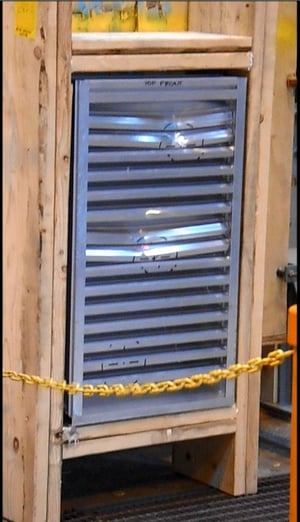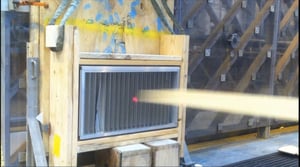AMCA Standards 540 and 550 are the latest testing standards for hurricane louvers. But are they better? This article covers AMCA 540-550 and compares them to the original Miami-Dade Standards.
Two Sets of Standards - AMCA and Miami-Dade
.png?width=300&height=403&name=EA-731-D%20-%20Hurricane%20Louver%20(Resize).png)
When building along the East coast, or near coastal areas, your project will have additional requirements for hurricane preparedness.
Severe weather louvers will need to be even more resilient in a hurricane: they will need to resist excessive amounts of rainfall blown and debris, carried by hurricane-force winds.
Manufacturers design hurricane louvers specifically for these requirements. They test each hurricane louver to specific standards before approving it for a hurricane zone.
The Air Movement and Control Association established AMCA Standards 540 and 550 to ensure all hurricane louvers meet these requirements.
There is a second set of standards still in use today, set forth by the Florida Building Code. The Miami-Dade standards, named after Miami-Dade County in Florida, are also standard for determining a louver's resilience.
Read to start your next project? Contact Arrow United Industries today! Let's meet your requirements together!
The Florida Building Code and Miami-Dade
The Florida Building Code contains several definitions and standards pertaining to hurricane preparedness:
- TAS 100A: a standard for testing a louver's resistance to high wind and wind driven rainfall.
- TAS 201: a standard for testing a louver's durability against windborne debris.
- TAS 202: a standard for testing a louver's resistance to rainfall at uniform static air pressure.
- TAS 203: a standard for testing a louver against cyclic wind pressure loading.
A hurricane louver must pass these tests and must seek further approval from the Miami-Dade Building Code Compliance Office (BCCO). Once approved, you can install the hurricane louver where required. AMCA Standards 540 and 550 have similar test methods as the TAS standards, but with certain differences that make them more stringent.
The best way to understand these differences is to compare the two standards. Let's start with the windborne debris requirements, tested by TAS 201 and AMCA 540.
.webp?width=500&height=276&name=Strong%20Winds%20(Resize%2c%20HS).webp)
For more on louvers, check out these Newsstand articles:
- The Condenser - Chevron Blades for Severe Weather
- Louvers by the Numbers
- The Condenser - Product Spotlight: The AS3D99VS
AMCA 540 and TAS 201 - For Impact Resistance
Both TAS 201 and AMCA 540 simulate windborne debris with an air-powered cannon. This cannon fires a 2" x 4" piece of timber at a sample louver mounted in a test assembly. Testers strike the sample louver in key places across its face, including areas where the louver's blades connect to the frame. This action simulates wind borne debris striking the louver during a hurricane.

To pass, the louver's blades must remain firmly affixed to the frame and its frame must remain intact.
The louver will fail if a blade comes loose, or if the frame is bent out of shape. These test methods ensure that each hurricane-rated louver can withstand strikes at key points and remain intact.
The difference between these two test standards is in the details. For TAS 201, the sample louver is required to be sized to its maximum dimensions (maximum width and maximum height). Once it passes, the approval applies to the louver's maximum size and all smaller sizes.
While they may seem effective, the sizing methods of TAS 201 do not consider certain factors specific to louvers. Louvers will vary as they increase or decrease in size.
The sizing methods used for TAS 201 assume that smaller louvers will withstand an impact better than larger louvers. However, smaller louvers have fewer blades and smaller frames than their larger counterparts. This makes them more susceptible to damage when struck by debris.
Larger louvers may also require blade supports for proper installation. These supports are affixed to the back of the louver’s blades and anchored to the opening. This keeps the louver blades rigid across the width of the louver, ensuring that they don’t warp during standard operation.
Independent tests determined these supports could absorb the brunt of the missile impact, without affecting the louver's blades or its frame. These supports could skew the results of the impact test: an approved louver might fail the impact test without these supports in place.
AMCA 540 has stricter requirements on the size of tested louvers. Manufacturers must provide four sample louvers at specific sizes:
- A louver at maximum width and a minimum height of 36 inches. This louver must have five blades.
- A louver at maximum height.
- A louver at maximum width.
- A multi-panel louver assembly, where each panel is maximum width.
The tests do not allow blade supports for any sample size. Each of the four samples must pass the impact test for the louver to be approved under AMCA 540.

Another difference involves the air-powered cannon used to simulate windborne debris. TAS 201 requires the distance between cannon and sample louver to be nine feet plus the length of the 2" x 4" missile used. If the test uses a missile that is six feet long, then the cannon will be 15 feet away from the sample louver.
AMCA 540 uses a shorter distance between louver and cannon: 1.5 times the length of the missile. Assuming the test uses a six-foot-long missile, the cannon would only be nine feet away from the sample louver.
The missiles in each test will have the same initial velocity when launching from the cannon, but the missile launched in the AMCA 540 test will have a shorter distance to travel. This translates to a greater force when the missile strikes the sample louver, which makes the test more difficult to pass.
For windborne missile impact testing, AMCA 540 is the more stringent and more comprehensive standard:
- It requires that four sample louvers pass the impact test versus the one sample louver required by TAS 201.
- It requires a multi-panel louver assembly as one of the samples, whereas TAS 201 does not require one.
- It requires a shorter distance between launcher cannon and sample louver versus TAS 201.
The International Building Code (IBC) has adopted AMCA 540 as a requirement for hurricane louvers. The 2010 edition of the Florida Building Code requires that louvers pass the AMCA 540 test standard when installed in windborne debris regions.
.png?width=540&height=300&name=Hubspot%20Blogs%20-%20AMCA%20540%20-%20wind%20debris%20(Resize).png)
In 2012, the International Building Code added AMCA 540 test requirements to louvers installed in windborne debris regions. Both the IBC and FBC use the same criteria to define these regions: areas with wind velocities greater than 140 mph and areas within one mile of the coastline with wind velocities greater than 130 mph. Louvers installed in these areas - within 30 feet of the building's grade or lower - must pass the AMCA 540 missile impact test.
AMCA 550 and TAS 100A - For Wind Driven Rainfall
.png?width=300&height=355&name=EA64C%20-%20Combination%20Adjustable%20Hurricane%20Louver%20(Resize).png)
If AMCA 540 tests a louver's resilience to windborne debris, then AMCA 550 tests its ability to block heavy rainfall.
Its proper name is AMCA Standard 550 Test Method for High Velocity Wind Driven Rain Resistant Louvers. The Miami-Dade equivalent testing standard is the TAS 100A.
Both tests determine a hurricane louver's effectiveness against blocking heavy rainfall driven by high winds.
The Miami-Dade BCCO requires TAS 100A testing for louvers installed "in a location where the room behind the louver is not designed to drain water penetrating into the room, or the room will house non-water-resistant equipment, components, or supplies". This requirement now includes AMCA 550 as an acceptable substitute for TAS 100A.
The test methods for AMCA 550 simulate the intense winds and heavy rain of a hurricane. Testers mount a sample louver into a makeshift wall with a collection chamber inside the opening. This chamber has an open top to allow constant air stream through the opening. Plastic material lines the chamber's walls to funnel any penetrating water into a channel, which leads to a metered bucket on the floor. The metered bucket will collect and measure any water that passes through the louver.
This test setup is like the one used for standard wind driven rain testing, in accordance with AMCA 500-L. Learn more about standard wind driven rain testing in this article.

During the test, sprayers inject water into an air stream and directed at the mounted sample louver. The test starts at a simulated wind speed of 35 mph, then goes to 70 mph, then 90 mph, and 110 mph to conclude the test. The water stream will remain at a constant flow throughout the test, to simulate 8.8 inches of rainfall per hour.
For each interval, the test assembly subjects the louver to a predetermined wind speed and rainfall rate for 20 minutes. Then, the water stream stops, and the air stream continues flowing for 10 minutes. Each interval is 30 minutes in duration: 20 minutes with water, and 10 minutes of dry air.
.png?width=300&height=200&name=EA-64%20-%20%20Hurricane%20Louver%20(Resize).png)
Testers examine the collection bucket at the end of each test interval. The water in the collection bucket must not exceed one percent (1%) of the total volume of water applied throughout the test interval.
The louver will fail the AMCA 550 test if the amount of water penetration exceeds one percent of the total test volume at any test interval.
The louver must block 99% of water applied to the air stream at 35 mph, 70 mph, 90 mph, and 110 mph to pass AMCA 550. TAS 100A only requires test intervals at 35 mph and 70 mph but requires that no water penetrates the louver at either velocity. Even so, AMCA 550 is considered an acceptable substitute..png?width=776&height=400&name=Hubspot%20Blogs%20-%20AMCA%20540%20-%20hurricane%20lineup%20(Resize).png)
AMCA Standards 540 and 550 ensure that each hurricane-rated louver withstands severe weather. Louvers must meet the most stringent standards in the industry to bear the AMCA seals for AMCA 540 and 550.
AMCA 540 and 550 are new standards for severe weather louvers, but they've been part of the industry for some time. When did you first hear about AMCA 540 and 550? Are these standards common in your line of work? Tell us in the Comments section. MCDLG wants to hear your thoughts!
Do you have a question on something we haven't covered here? Contact MCDLG by clicking on the button below.
.webp?width=91&height=70&name=MCDLG%20Logo%20(Resize).webp)
.webp)





